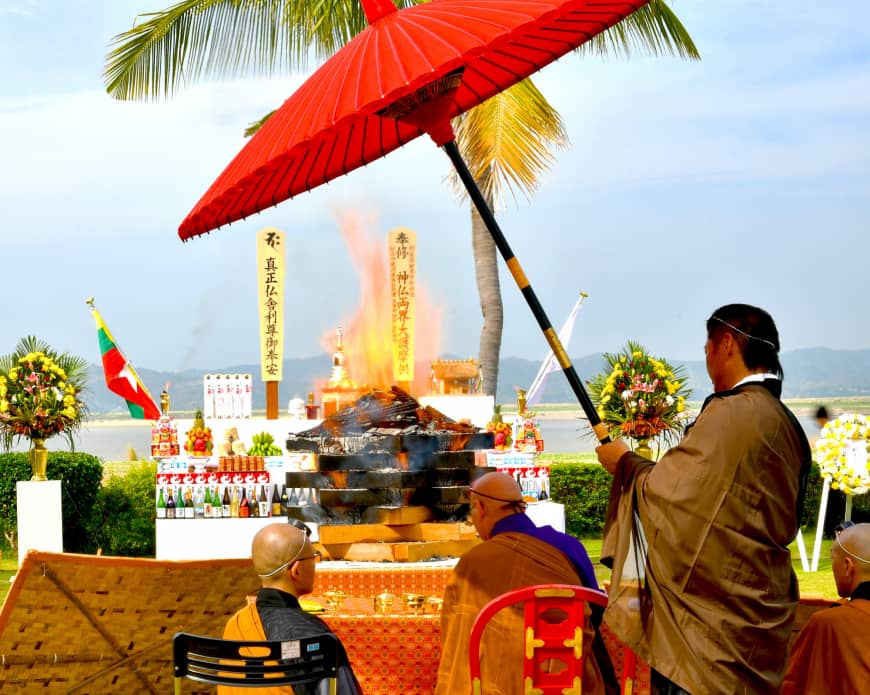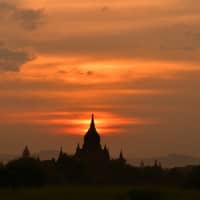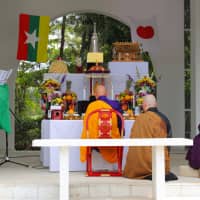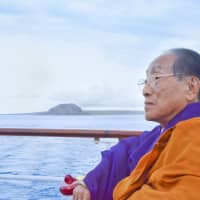Many countries, including Japan, have been providing aid to Myanmar as the Southeast Asian nation moves toward democracy. But many people don’t realize that the Japanese military ruled the country from 1942 until 1945, when it was a British colony known as Burma. Tens of thousands of soldiers on both sides, as well as civilians, died or were wounded.
In order to assuage the souls of the war dead in Myanmar, members of Japan’s Agon Shu Buddhist Association held a series of solemn rituals there in November. It had long been the wish of the association’s founder, the late Reverend Seiyu Kiriyama, to visit Myanmar to perform a “battlefield pilgrimage.”
Rev. Kiriyama’s message
Before he died in August 2016, Kiriyama prepared a message to the war dead. “We come here today to pray for you, the holy spirits, for your peaceful repose and to set up a shrine to send you back to Japan,” he noted. “I apologize to you for keeping you waiting for such a long time. You must have had hard times. When you come back to Japan, all Japanese people will bow deeply to you to show their thanks. I greatly appreciate all of your hardships and express my gratitude from the bottom of my heart.”
On June 17, Agon Shu held a memorial ceremony for the war dead in Singapore in preparation for the pilgrimage to Myanmar. On Nov. 3, a departure ceremony was held at Agon Shu’s head temple in Kyoto. Kiriyama’s sacred ashes were reverently placed on an altar as prayers were offered for the success of the pilgrimage.
Spiritual truth
Kiriyama founded Agon Shu in 1978. After many years of seeking the ultimate spiritual truth, he realized that the method of attaining Buddhahood in the Agama Sutras — the original source of Buddhist doctrine — was what he was looking for. Agon Shu has since grown into a community of Buddhist followers with 64 institutions in Japan, ordained priests, nearly a half a million believers in Japan, and thousands more overseas.
The 150-member Agon Shu delegation, accompanied by Kiriyama’s sacred remains, left for Myanmar on Nov. 3, along with representatives of the Pacific War Memorial Association and Tokyo’s Yasukuni Shrine, which honors Japan’s war dead.
‘Skeleton road’
The first ceremony was held in the city of Sagaing. Many soldiers from Japan’s disastrous World War II Imphal Campaign in western Burma who fled toward Sagaing died along the way, and the road to the city became known as the “Skeleton road.”
At the top of a hill is a pagoda built by an association of surviving soldiers and bereaved families of dead members of the 138th Regiment of the 31st Division of the Imperial Japanese Army. Agon Shu held a Goma Hoyo fire rites ceremony there on Nov. 7 to pray for the souls of the war dead and for world peace. The Agon Shu faithful believe that the souls of the Japanese soldiers, many of whom died of disease, starvation or exhaustion, were led to heaven by the power of the late founder’s sacred remains and the sacred flames into which wooden votive tablets were thrown.
Rituals at Yangon cemetery
On Nov. 8, the delegation arrived in Yangon, Myanmar’s former capital and the country’s largest city. The next day, the members of the delegation and local dignitaries gathered at a peace monument built by the Japanese government at a cemetery where many Japanese war dead are buried.
A message of condolence from Prime Minister Shinzo Abe was read, followed by priests from Tokyo’s Yasukuni Shrine performing Shinto rituals. Senior Agon Shu priest Seia Fukata then officiated a service for the war dead.
The venerated light from the late founder’s sacred remains radiated from the altar and reached all those buried in the cemetery and the other war dead throughout Myanmar. Everyone attending the ceremony was moved by the light.
Leading souls to heaven
On Nov. 10, the delegation arrived at Bagan, a major archeological site featuring more than 3,000 pagodas. In this spectacular setting, Agon Shu, on the following day, held a series of rituals comprising a prayer for world peace, a memorial service for the war dead, an invocation of Shinto and Buddhist deities, and another Goma Hoyo ceremony.
The holy flames rose to lead the souls to heaven and send them back to Japan. The Agon Shu faithful believe the power of the fire rites ceremony also reached the Allied war dead and civilian victims.
Sixty-eight Agon Shu temples, halls and branches, both in Japan and overseas, held memorial services at the same time as the ritual in Bagan, increasing the event’s spiritual power.
Members of the delegation then boarded a boat that took them on a brief cruise on the Irrawaddy River. Against the beautiful backdrop of the setting sun, they scattered offerings to commemorate soldiers who drowned in the river. It set an appropriately meditative mood for the conclusion of a deeply moving spiritual journey.


 Click to enlarge
Click to enlarge



